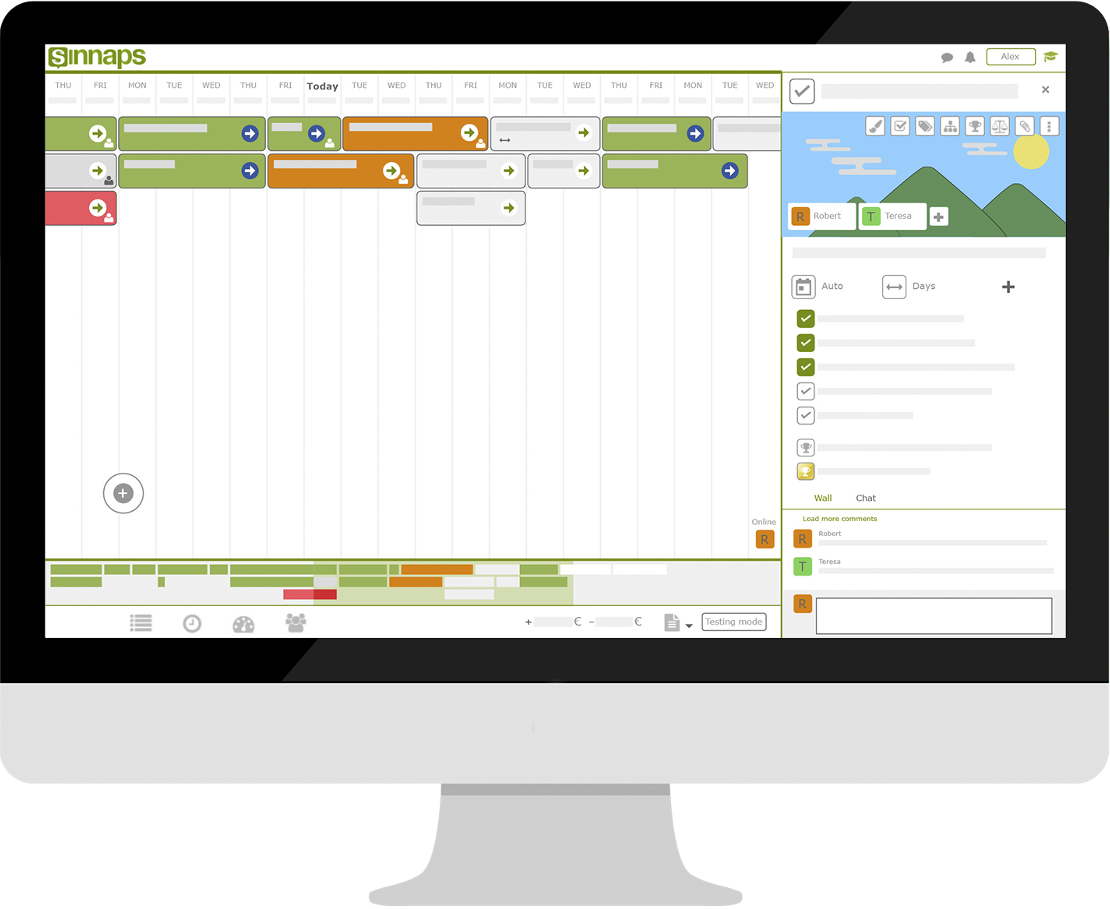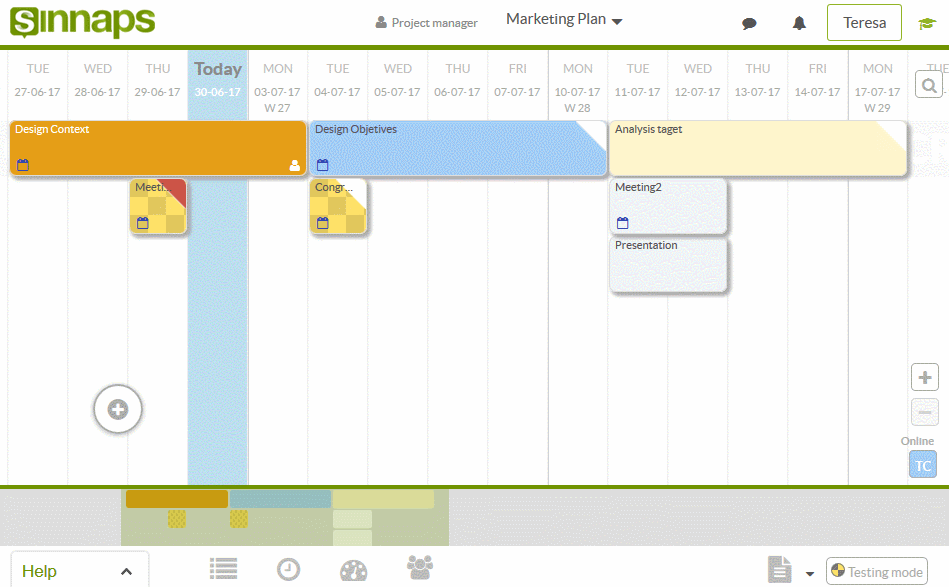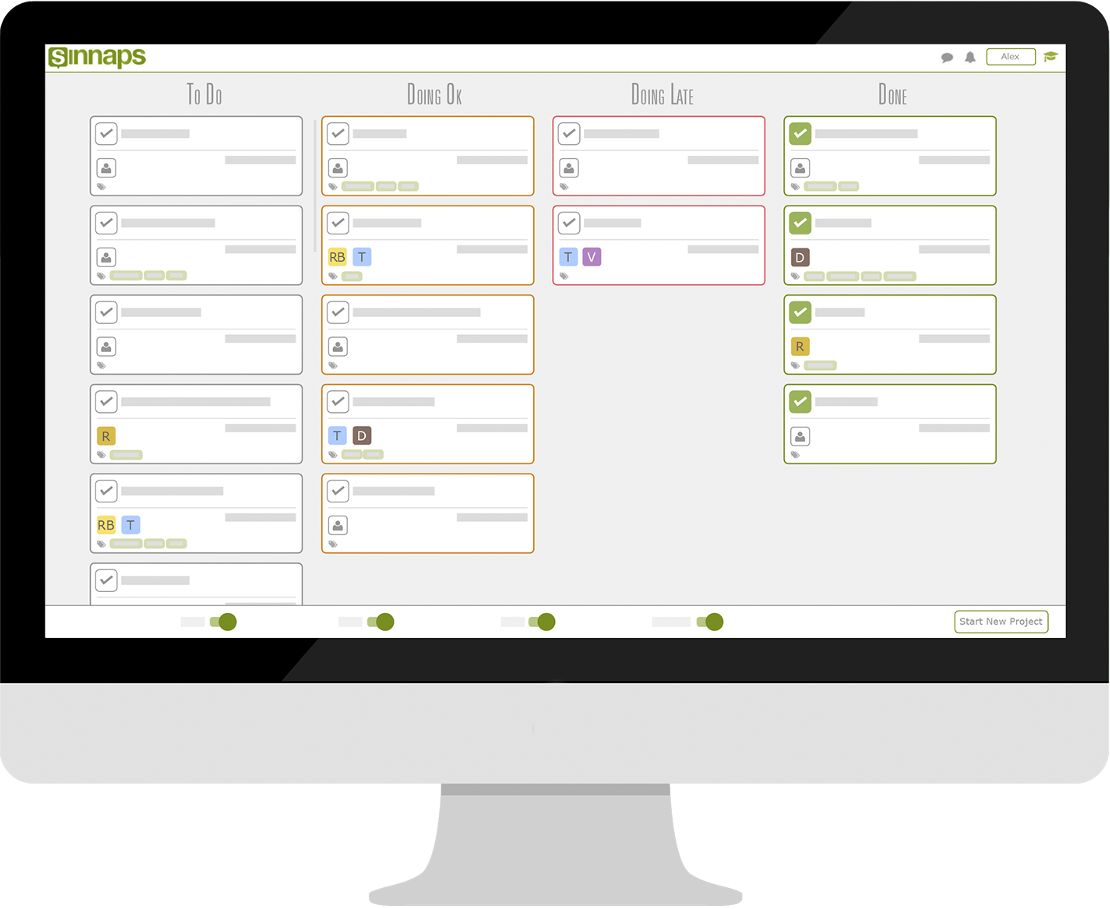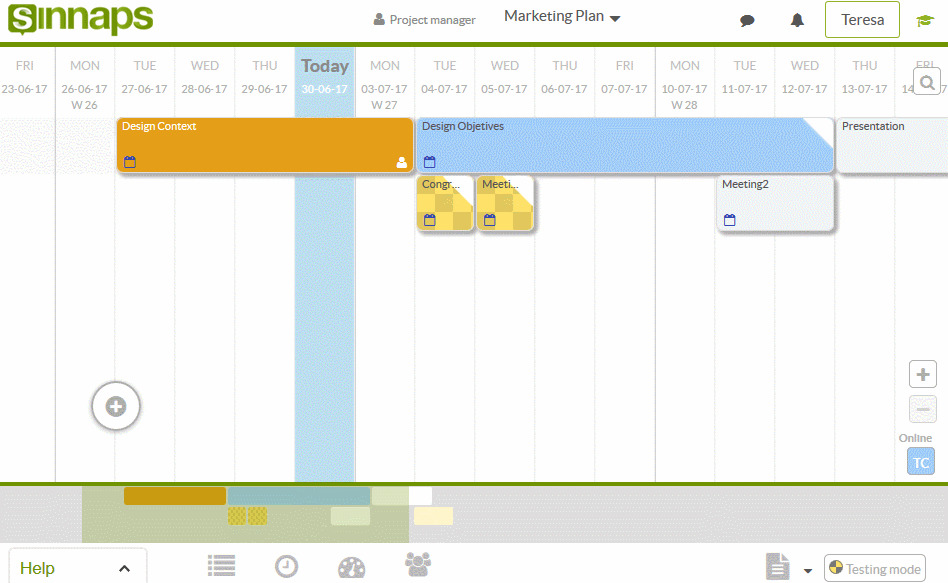Every project design tells its own story about its various goals, team resources, etc., and detailed project planning is required to get the story right. Every story is based on an outline and in the project management world, a project plan. In this article, you will read about what is the design of project work, how to plan a project, what constitutes a project design proposal, what project design tools are available and why Sinnaps is your best choice.
Índice
What is Project Design?
Project design is one of the earliest steps in online project management, where essentially the project and how it will run are planned. More specifically a project designer plans a project’s deliverables, structure, criteria and key features. The Project Manager details how the project will be managed. A project plan gives the layout of all the parts of the project that need to be managed to make it successful. It is the process of establishing the scope, defining the objectives and steps to obtain them. It is one of the most important of the processes that make up project management.
Another important stage in designing a project plan is figuring out its budget and how much it will cost. This is very relevant to the various stakeholders, funders and other managers who all have a stake in the project itself. Usually, stakeholders are presented with several project file design options and then pick what they believe to be the best one for the effective execution of the project.
A project design can come in many different formats, such as sketches through project paper design, flowcharts, HTML screen designs, prototypes and more. Commonly a project plan is presented in the form of a Gantt chart, an option Sinnaps provides. It is an effective and easy way to present and communicate project design to stakeholders and to the team itself. Project design differs fundamentally from the operational planning stages in the sense that one thinks at a deeper level about how the project itself will be managed.
Questions such as who has the authority and how will decisions be made, what staff training is required and when does the money must be secured to begin the project? Are asked and decided.
Presently, per current needs of projects, agile and flexible plans tend to be created and followed. The techniques used in project design allow for the flexible execution of activities. Plans are created considering constant change and the need for flexibility. In online platforms and especially that of Sinnaps, this is something we take highly into account.
Some of the main benefits of a project plan include:
- Identification of costs and time frames for the project itself
- Use in support of funding applications for the project
- Constant revisions
- Effective responses
- Management of uncertainty
- Reduced response time to contingencies
- Results oriented to the needs of the project/client

What is a Company trying to achieve with project planning? The following are some of the most important reasons:
- Risk management
- Productivity and effectiveness
- Control and monitoring of results and daily work
- Fast Decisions and Business Competitiveness
- Results focused on the client or project owner
- Continuous improvement of previous successful planning-based production processes.
- Well-being and satisfaction of the work team. Effective project planning and its success benefits the work climate greatly, improving relations between team members and team leaders.
Project Work Designs
The work within a project must be planned carefully and managed appropriately. Designing projects for them to serve as lessons and examples of what worked and didn’t work for the future is even more important. A work breakdown structure, which means breaking the project as a whole into more manageable chunks and giving more specific detail about each chunk, team members more easily understand what is being asked of them. Taking the following into consideration can further improve your project work design.
- Select and focus on an area that could use some improvement. Enthusiasm should be stimulated to face a challenge and will allow for learning. In this way, designing a project plan will add value to the team.
- The design of project work should include goals that are realistic and clear. This can be done by relating each goal with specific results. In this way, team members will understand what exactly is being asked of them and will understand when they have achieved the goal through achieving the desired result.
- Make the project goal but serve as a challenge. It should be something more advanced than to what the team is accustomed. If the goal is too easy it will not serve in skill development. The goal is for people and team members to push their limits and try new things. However, it cannot be so ambitious that the team members are incapable of completing it. It is important to strike a balance between challenging and achievable.
- After designing a project plan, get people to begin straight away, even if the it is set for 6 months out. Don’t let your team ‘leave it until later’, because time flies faster than you think. Set a shorter deadline so that there is enough time to complete the project well and that team members keep it at the top of their minds. Urgency can push towards rapid skills development which is a bonus for the team and team members individually.
- Allow for previous projects to serve as learning tools in the future. Teams can see how a project plan worked in one context, such as a previous global design project and to see if it is applicable and how it needs to be modified to fit in another, more local context, for example. This allows for the team to become adaptable as the gain more knowledge and experience with each project they participate in.
At Sinnaps we understand that project design is ultimately like telling a story. Before designing a project, you must understand its context. Different scenarios can be proposed and the best and most optimal then chosen. After understanding the target, the limitations and the objectives that we want to achieve, a story can be put together and therefore a project planned.
How To Design a Project Plan?
Project management is mainly based on the development of strategic planning of a company, as long as it considers several key factors. When planning the design of project work, the following are the key factors to be taken into account. These key factors are to what Sinnaps pays close attention:
- Critical Activities or Critical Path
- Dependencies between activities
- Necessary and available resources
- Consumption of resources
- Planned costs and actual costs
- Fixed periods
- Teamwork
- Uncertainty, risks and project simulations
- Setbacks and Wildcard Activities
- Stakeholder/participant relations
- Lessons Learned and Saved Processes

Planning a Project is similar to telling a story
A story has a beginning, middle and end and follows a certain path. In the same way, there are a number of steps to take at the beginning, middle and end of planning or designing a project.
-
- Define the current situation and what are the main objectives and goals to be achieved upon project completion.
- Hold a kick-off meeting and establish a plan of action with your team.
- Draft your project and meet with those responsible. Drafting can be done through project paper design. The design of project paper should be clear and appealing to read.
- Plan the activities and tasks that will make up the project.
- Assign the various tasks to corresponding team members. Team members can resolve any doubts or ask for feedback with Sinnaps in-chat tool.
- Take a realistic approach in resource allocation. Sinnaps allows for resources to not only be updated when needs be, but also for in chat communication where team members can discuss what resources are really needed. Sinnaps optimises your resources and gives each resource value depending on it can be used.
- Execution of the project. Any change that need to be introduced along the way can be easily added with Sinnaps flexible planning tool that allows for the addition and automatic integration in the project.
- Continuous communication of strategy, any revisions, milestones achieved and project monitoring. Continuous evaluation of how the project is going is very important as it allows you to see if you are on track or not. Sinnaps allows for this through a weekly update of how everything is running in your project. The project wall also allows for everyone involved to see what is happening throughout the whole project.
- Close the project when it is completed. Hold a final team meeting and review the lessons learned in planning. If it was successful it can be saved as a workable process to be re-used at a future time. Sinnaps allows you to save previous project design templates so that they can be easily and quickly filled out when another similar project comes around.
Sinnaps is a project management tool that can hugely aid in effective project design through our adaptation of the Gantt Chart: the Gantt-flow. Some of our most useful features include instant chat, subtask management, critical path, task dependency calculation and the management of resources.
With Sinnaps, a Project Manager or Project Designer can simulate scenarios when planning a project on Test Mode. Other stakeholders or team members can also be involved in the planning process and validate the potential tasks and activities that are proposed through the activity or Kanban board.

Unlike other Project management software, Sinnaps designs and optimises workflows and any changes introduced automatically using system design projects. This eases what could be a complicated task dramatically. PERT (Project and Evaluation Review Techniques) and CPM (Critical Path Method) are the techniques that aid in the optimisation of planning, prioritising and designing workflows. Automatically, each activity added or modified is defined and its position optimised.
Additionally, every time a change is introduced (which can be often!) Sinnaps will show the impact that change has on the rest of the activities and on the project as a whole. This considerably reduces human error in complex projects and allows for greater flexibility and faster response to unexpected setbacks, something common especially in a larger-scale, global design project.
Project Proposal Design
A well-thought-out project proposal design can be a best selling tool, if executed correctly. They can also serve as a great deal of stress for some due to their complexity, such as a global design project and potential risk of not working out as planned. Sinnaps help to dramatically reduce the complexity of project design through a modern and user-friendly tool called the Gantt-flow.
Through PERT and CPM technologies, resources and any changes are allocated automatically and the critical path to be followed is clearly defined. Even though it is a creative process, even the most uncreative can come up with a project design proposal, especially with the help of Sinnaps.
Firstly, before drawing up a small or global design project proposal you should sit down with your client and review the project. You should understand the project and what is the desired goal to be achieved at the end of it. You should also gather any relevant facts that could come in use when designing the project.

Secondly, you should do some of your own research in terms of your client’s competition.The fact the the clients or your team are under performing in a certain area can affect the project and the project report design and on what is focused on in a certain way. Get a picture of the competitive environment.
After the initial project file design using the Gantt flow, the team involved keeps the project up to date, adding value to the PM. The Project Manager is the person that makes the main decisions about the project, controls the risks and the progress and adds value to the company director. Different side designs for projects can be created and the most suitable one is chosen. In the end, it is the company’s director that decides whether to use the project file design on Sinnaps or not.

You can save several scenarios of your planning.
After gathering all this relevant information, you can begin to draw up the project design proposal and the design of project work for your client or team. This is typically divided into 10-13 categories, depending on each project. Although this is a more traditional approach to project design, understanding it can help you in your new, modern techniques.
Executive Summary
This is normally a 1 or 2-page overview of the proposal as a whole. You should be writing this at the end so that you yourself can see the whole proposal. It is very important as clients will look here or the budget first.
Current Situation
In your project proposal design, you should include an overview of where the client is at as of now. Their situation that has pushed them to need a project in the first place, so to speak. It will include the key issues or problems and what their goal at the end of the project is.
Project Goals
This is a summary of all goals desired by the time the project is completed. Not only the main goal is included here, but also smaller goals that can be accomplished through individual activities with the project itself, for example.
Competition
Here, you should demonstrate what you learned about the client’s competitive advantage. You should explain clearly that competition is doing better on x aspects and worse on y aspects. Due to these findings, you will proceed and focus on certain key areas. Document where your client is lacking and where they are shining as explanation for your future moves.
Audience
In this section, you are basically giving an overview of your client, what they believe in and what is important to them. This will show your understanding of your client and make them feel more comfortable towards your project proposal design.
Creative Strategy
This is one of the most important sections of the proposal. The idea is to describe what you plan to do, how you will meet the goals of the project and strongly compete in the market. All of this is to be done while keeping within the specified budget and on schedule.
Process
Here you should describe the specific steps to be taken to reach your client’s desired goals. Each task should be detailed from beginning to end and most importantly, justifiable.
Fees & Reimbursements
This section is simply the budget. In this section, you should clearly state how much your services will cost etc. Each task should be listed out with a monetary figure alongside.
In the Billing and schedule section you’ll lay out the production schedule and when you are to be paid. As a general rule of thumb, always under promise and over- deliver. This way you’ll always be the hero and heighten your reputation. Copyright issues can also be taken care of in this section.
Conclusion
The conclusion section is basically one big overview of the whole project. It is a recap of what you are going to do and why your client made the right decision in choosing you. Remember, your project report design should be attractive in presentation. It may be superficial, but people pay more attention to detail than you may think!
Company Overview, Clients & Awards
In this final section, you talk about yourself. Speak of the clients you have worked for, your own business background and your experience. Show your client that you are the right person for the job. You can even include some client testimonials to back-up your points. Make sure your project proposal design grabs the attention of your client or team and gives them exactly what they are looking for!
Sinnaps is an online platform that avoids the problem of the dreaded complex project design and has created an easy, effective, interactive and efficient way to plan and manage projects for project management. The way in which Sinnaps orders out the activities in the workflow gives us a lot of information about the project itself. However, it is also important to understand the basic premises that Sinnaps utilises for the design of project work will help you to understand how to plan your project online with the app in the simplest way possible. Start a project, plan and design your projects effectively and with ease today!

